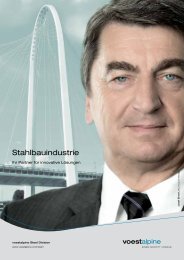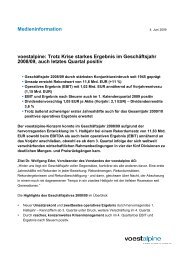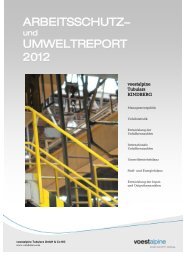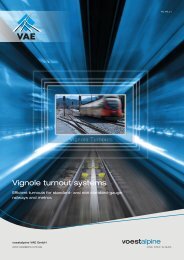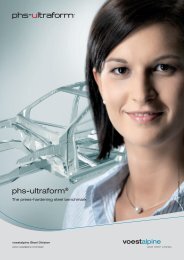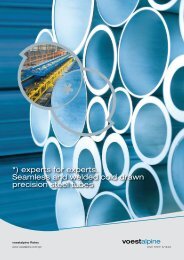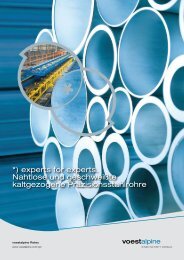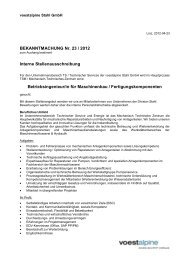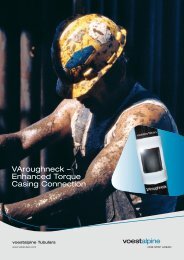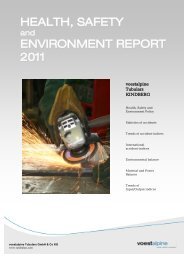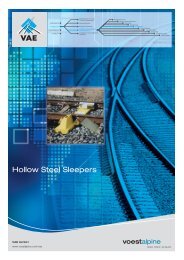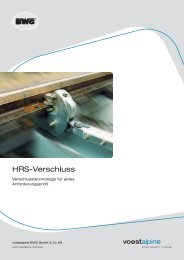VAE ROADMASTER 2000 - voestalpine
VAE ROADMASTER 2000 - voestalpine
VAE ROADMASTER 2000 - voestalpine
You also want an ePaper? Increase the reach of your titles
YUMPU automatically turns print PDFs into web optimized ePapers that Google loves.
WDS.01<br />
<br />
<br />
<br />
<strong>VAE</strong> <strong>ROADMASTER</strong> <strong>2000</strong><br />
<strong>VAE</strong> GmbH<br />
www.<strong>voestalpine</strong>.com/vae
2<br />
<strong>VAE</strong> <strong>ROADMASTER</strong> <strong>2000</strong><br />
Due to the economic and technical<br />
changes in railway and<br />
infrastructure enterprises, there<br />
are increasing requirements for<br />
track availability. As a result, maintenance<br />
and diagnostic systems<br />
are valued more than ever.<br />
The conversion to condition-oriented<br />
maintenance, continuous remote<br />
diagnostics and mechanism to detect<br />
localised point failures instantaneously<br />
and safely will be the crucial<br />
parameters for the economically<br />
conscious enterprise in the future.<br />
Maintenance and diagnostic systems<br />
are indispensable instruments<br />
for use as saving potentials.<br />
In order to optimise respective applications,<br />
decisions must be made to<br />
which sections of the infrastructure<br />
network should be monitored in<br />
accordance to the usage type and<br />
demand of supervision. Modularly<br />
developed diagnostic systems<br />
are capable of dealing with every<br />
situation to find the best solution.<br />
Trough the combination and/or<br />
integration of modular systems<br />
in superordinated maintenance<br />
and management systems the<br />
optimisation of the cost-use<br />
relationship is easy to realise.<br />
<strong>VAE</strong> Eisenbahnsysteme GmbH<br />
since the early 80‘s dealt intensively<br />
with the topic of remote diagnostics<br />
of stationary controls with<br />
the emphasis of switch diagnosis.<br />
The goal of the development was<br />
to improve and optimise track<br />
availability, early recognition and<br />
predictability of failures as well as<br />
the reduction of the Life Cycle Costs.<br />
The collected know-how during<br />
this development process led to<br />
a modular, intelligent diagnostic<br />
system <strong>VAE</strong> <strong>ROADMASTER</strong> <strong>2000</strong>.<br />
This system is captivated by its<br />
expandable structure and possibilities<br />
for adjustments to fulfil all customized<br />
or installation-specific needs.<br />
Sensors with covers installed in a turnout
3<br />
<strong>VAE</strong> <strong>ROADMASTER</strong> <strong>2000</strong><br />
Reasons to use <strong>VAE</strong> <strong>ROADMASTER</strong> <strong>2000</strong>:<br />
u<br />
u<br />
u<br />
u<br />
u<br />
u<br />
u<br />
increased availability<br />
early recognition of disturbances<br />
reduction of operational failures<br />
exact error analysis<br />
reduced maintenance expenditures<br />
conversion from period-oriented<br />
to condition-oriented maintenance<br />
cycle<br />
ideal instrument for planning the<br />
necessary maintenance tasks<br />
u<br />
u<br />
u<br />
u<br />
enormous relief of maintenance<br />
work on services with limited<br />
access (e.g. tunnels)<br />
decreased installation expenditure<br />
due to exact information<br />
from the system<br />
contribution to environmental<br />
protection - lubrication only if<br />
needed<br />
reduction of the Life Cycle Costs<br />
(LCC)<br />
u<br />
u<br />
u<br />
protection of the maintenance<br />
personnel<br />
reduction of entering into danger<br />
areas<br />
decreased duration of stopover<br />
time in the danger area by giving<br />
precise information about the<br />
conditions of the switch<br />
<strong>VAE</strong> <strong>ROADMASTER</strong> <strong>2000</strong> SYSTEM DESCRIPTION<br />
Every individual section face special<br />
challenges and its weighting are<br />
determined by the local situation,<br />
economic base conditions and operational<br />
characteristics. The range<br />
of variation necessitates a modular<br />
system structure. The <strong>VAE</strong> ROAD-<br />
MASTER <strong>2000</strong> is individually developed<br />
from a basic version up to a<br />
fully developed distance monitoring.<br />
Depending on the special conditions<br />
and customer‘s request, each switch<br />
can be equipped with the economical<br />
version (<strong>VAE</strong> <strong>ROADMASTER</strong><br />
<strong>2000</strong> Light) or extension of several<br />
parameters to a more comprehensive<br />
diagnosis (<strong>VAE</strong> <strong>ROADMASTER</strong><br />
<strong>2000</strong> Advanced/Pro). The system’s<br />
versatility makes optimisation<br />
of cost/use relationship a reality<br />
for the infrastructure operator.<br />
The function of the <strong>VAE</strong> ROAD-<br />
MASTER <strong>2000</strong> is based on the<br />
evaluation of measured data.<br />
This takes place in conjunction<br />
with the operation of intelligent<br />
software, which recognises errors<br />
at the switch before a disturbance<br />
occurs by comparing the data with<br />
reference values. According to<br />
the output values error messages<br />
are generated automatically and<br />
transferred to the skilled personnel.<br />
In order to increase the accuracy of<br />
error recognition and avoid unnecessary<br />
alarms, the reference values<br />
are based on a highly developed<br />
algorithm which considers local conditions<br />
and weather-related changes.<br />
By many years of experience and<br />
know-how that forms the evaluation<br />
software, it is guaranteed that the<br />
system recognizes all initiating<br />
errors. This allows the infrastructure<br />
operators to plan for repairs<br />
before disturbances even occur.
4<br />
<strong>VAE</strong> <strong>ROADMASTER</strong> <strong>2000</strong><br />
Electronic evaluation module<br />
Advantages of the <strong>VAE</strong> <strong>ROADMASTER</strong> <strong>2000</strong> system<br />
u<br />
modular system structure - adaptable to every customer needs and easily<br />
expandable at any time<br />
u<br />
u<br />
intelligent evaluation software<br />
automatically generate error messages<br />
u<br />
integration into superordinated maintenance management systems<br />
possible<br />
u<br />
u<br />
u<br />
no effect on existing supervised switches<br />
continous data acquisition<br />
applicable from suburban traffic to high-speed lines<br />
Current Sensor in Operation Room<br />
u<br />
data access directly at the switch possible by several mobile solutions<br />
(GPRS, UMTS, laptop, Handheld...)<br />
u<br />
additional alarm directly to your mobile phone<br />
u<br />
u<br />
transfer and network integration of the collated data to a control station<br />
can be customised to the adapted format<br />
data evaluation directly for the customer on a locally installed server<br />
- exclusivity of all data<br />
u<br />
remote support of <strong>VAE</strong> specialists – if required<br />
u<br />
simple integration of already existing monitoring and diagnostic<br />
information<br />
u<br />
- simple control surface<br />
Inductive Sensor<br />
Availability and Maintenance Costs
5<br />
<strong>VAE</strong> <strong>ROADMASTER</strong> <strong>2000</strong><br />
Depending on the special requirements<br />
and conditions the <strong>VAE</strong><br />
<strong>ROADMASTER</strong> <strong>2000</strong> system can be<br />
offered in three development stages.<br />
<strong>VAE</strong> <strong>ROADMASTER</strong> <strong>2000</strong> Light<br />
This version the diagnostic<br />
system evaluates the current<br />
flow during switch operation.<br />
The data are economically collected<br />
in a central signalling centre<br />
for several turnouts. However if<br />
necessary the collection can also<br />
take place directly at the switch.<br />
<strong>VAE</strong> <strong>ROADMASTER</strong> <strong>2000</strong><br />
Advanced<br />
With this adaptation a variety of<br />
different parameters are supervised.<br />
For this purpose various<br />
sensors are installed directly at<br />
the turnout and connected to<br />
integrated electronic components<br />
in the diagnostic network<br />
<strong>VAE</strong> <strong>ROADMASTER</strong> <strong>2000</strong> Pro<br />
In addition to switch diagnosis,<br />
most stationary installations can<br />
be integrated into the system. This<br />
allows a wide range of monitoring<br />
functions possible by a system which<br />
is developed individually for smaller<br />
sections and/or entire railway lines.<br />
The combination of the different<br />
versions is possible and permits<br />
optimum design of the system for the<br />
individual requirements of a modern<br />
railway company. The individual<br />
stages of development can be extended<br />
at any time by additional measuring<br />
points. The modular structure<br />
ensures an optimal cost/use relationship<br />
with the use of the diagnostic<br />
system <strong>VAE</strong> <strong>ROADMASTER</strong> <strong>2000</strong>.<br />
Principle of early failure recognition<br />
Current Sensor installed in Termination Box<br />
of Switch Point Machine next to the turnout
6<br />
<strong>VAE</strong> <strong>ROADMASTER</strong> <strong>2000</strong> LIGHT<br />
This version of our turnout monitoring<br />
system represents the basics of<br />
the <strong>VAE</strong> <strong>ROADMASTER</strong> <strong>2000</strong>. In<br />
this case the switch point machine<br />
is used as sensor for irregularities<br />
in the switch. For the measurement<br />
of the current non-reactive<br />
current transformer are used.<br />
With <strong>VAE</strong> <strong>ROADMASTER</strong> <strong>2000</strong><br />
Light it is possible to economically<br />
supervise multiple switches in a<br />
centralised signalling room. The<br />
measured local values are then<br />
transferred for further evaluation<br />
to a central or local computer.<br />
If technically necessary, the<br />
collection of the data can also be<br />
made directly at the switch. In<br />
this case additional electronics<br />
components have to be attached.<br />
The transmission of data to the<br />
controlling station is adapted to<br />
the customised format. Various<br />
solutions are possible from diverse<br />
wire transmission paths up to<br />
various radio network systems.<br />
For data evaluation the use of intelligent<br />
software is adapted according<br />
to the customer’s needs. This system<br />
does not only recognise the initialised<br />
errors, but also shows which<br />
switch components are affected.<br />
If necessary both the number<br />
of measuring points and<br />
supervised parameters can be<br />
supplemented at any time.<br />
User interface and generating<br />
of alarms is the same for all<br />
versions and is described in<br />
more detail in the chapter User<br />
interface and Data Retrieval.<br />
Current Sensor and Acquisition Electronics in<br />
the Signalling Room
7<br />
<strong>VAE</strong> <strong>ROADMASTER</strong> <strong>2000</strong> LIGHT<br />
System overview of<br />
<strong>VAE</strong> <strong>ROADMASTER</strong> <strong>2000</strong> Light<br />
Example of User interface<br />
SWITCH TO<br />
THE RIGHT TRACK
8<br />
<strong>VAE</strong> <strong>ROADMASTER</strong> <strong>2000</strong> ADVANCED<br />
In this development stage sensors<br />
are installed directly in the turnouts<br />
where multiple critical parameters<br />
in the switches can be supervised.<br />
The number of supervised points<br />
are specified according the situation<br />
and in coordination with the<br />
respective customer. The collected<br />
data from the switch will be transferred<br />
via acquisition electronics<br />
to the particular evaluation station.<br />
The transmission to the server<br />
room will be individually adapted<br />
to the customer’s conditions. A<br />
variation of transmitting media<br />
can be used from wire-bound<br />
up to radio network systems.<br />
The measured data will be evaluated<br />
with appropriate evaluation<br />
process, compared with reference<br />
values to make the early recognition<br />
of errors possible. Due to direct collection<br />
of the measured values at the<br />
switch errors can be limited. This is<br />
by far more detailed and exact information<br />
compared to the Light version<br />
of <strong>VAE</strong> <strong>ROADMASTER</strong> <strong>2000</strong>.<br />
The sensors require no additional<br />
maintenance and are conceived in<br />
such a way that they cannot have<br />
negative influences on the switch.<br />
If necessary both the number of<br />
measuring points and those of<br />
the supervised parameters can<br />
be at any time supplemented.<br />
User interface and generating<br />
of alarms is the same for all<br />
versions and is described in<br />
more detail in the chapter User<br />
interface and Data Retrieval.<br />
Inductive sensor to detect the switch rail<br />
position<br />
SWITCH TO<br />
THE RIGHT TRACK
9<br />
<strong>VAE</strong> <strong>ROADMASTER</strong> <strong>2000</strong> ADVANCED<br />
Overview <strong>VAE</strong> <strong>ROADMASTER</strong> <strong>2000</strong><br />
Advanced<br />
Possibilities of measuring points<br />
SWITCH TO<br />
THE RIGHT TRACK
10<br />
<strong>VAE</strong> <strong>ROADMASTER</strong> <strong>2000</strong> Pro<br />
Implementation of this diagnostic<br />
system could be extended to<br />
become the tool for monitoring<br />
all fixed installed assets along<br />
a specific length of a line or the<br />
whole line itself. The possibilities<br />
of monitored installations are<br />
nearly unrestricted from turnout<br />
heating systems up to crossings.<br />
measure additional values and<br />
monitoring of other installations<br />
integrated later into the system.<br />
User interface and generating<br />
of alarms is the same for all<br />
versions and is described in<br />
more detail in the chapter User<br />
interface and Data Retrieval.<br />
Integration of additional Installations<br />
For this reason diagnostic information<br />
could be gained directly with<br />
special sensors or if the installation<br />
itself has a self diagnostic system,<br />
information could be read out directly<br />
and be integrated into the <strong>VAE</strong><br />
<strong>ROADMASTER</strong> <strong>2000</strong> Pro system.<br />
However it is also possible to<br />
integrate the turnout monitoring<br />
solutions offered in the Light or<br />
Advanced versions into the <strong>VAE</strong><br />
<strong>ROADMASTER</strong> <strong>2000</strong> Pro version<br />
which is easily extendable to
11<br />
<strong>VAE</strong> <strong>ROADMASTER</strong> <strong>2000</strong><br />
Visualisation and data retrieval<br />
User interface and data retrieval<br />
could be realised on a special<br />
workstation or it could be integrated<br />
into an existing network as a client/<br />
server solution. Integration into the<br />
intranet makes information available<br />
in the whole network. Secure<br />
connection via web could be used<br />
and the use of mobile equipment<br />
to access monitored data. Access<br />
could be limited with passwords.<br />
All information and alarms are<br />
interpreted by the system and<br />
visualised in a user-friendly environment<br />
for efficient operation. All<br />
information is sorted into an archive<br />
and the system generates trend<br />
curves over a period of time for<br />
analysis of developing conditions.<br />
In the case of dangerous situation<br />
a signal alarm is immediately<br />
generated. With the trend curves<br />
the implications of maintenance<br />
works could be analysed.<br />
Alarms generated by the system<br />
will be sent to the defined receiver<br />
before a failure occurs. With this<br />
information repair works could be<br />
planned according to the priority<br />
of task. The system could also<br />
be integrated into an existing<br />
maintenance and malfunction<br />
management systems and all alarms<br />
could be handled within this tool.<br />
For notifying personnel there are<br />
various possibilities, for example,<br />
by email or SMS or any new forms<br />
of communication technologies.<br />
The possibility to get access detailed<br />
measured values in case of an<br />
alarm, enable personnel to specify<br />
and locate the reasons for alarms<br />
especially in larger turnouts. This<br />
could reduce time for failure repair<br />
dramatically. The user interface<br />
could be designed according to the<br />
customer’s needs. The <strong>VAE</strong> ROAD-<br />
MASTER <strong>2000</strong> diagnostic system is<br />
distinguished through its functionality,<br />
efficiency and user-friendliness.<br />
Overall view of a monitored station with additional<br />
links<br />
Values of a high speed turnout with alarms<br />
Presentation of a measured value
<strong>VAE</strong> GmbH<br />
Rotenturmstraße 5-9<br />
A-1010 Wien<br />
T. +43/1/531 18-0<br />
F. +43/1/531 18-222<br />
www.<strong>voestalpine</strong>.com/vae



